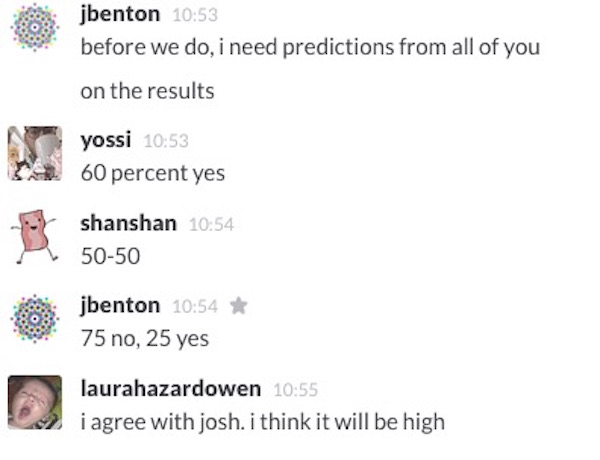
Twitter last week released its new poll feature, and users — at least the ones who’ve gotten access — have been asking their followers all sorts of important questions.
What should I eat for lunch today? Here's what I've found in the office kitchen:
— Joseph Lichterman (@ylichterman) October 26, 2015
Which wizard would you want on your squad
— Tweeted Polls (@TweetedPolls) October 27, 2015
Yesterday, we decided we wanted to try out a Nieman Lab poll, so we asked the big question of the day in medialand: whether our followers use an ad blocker. The poll was live for 24 hours; here’s what some of them had to say:
We're curious: do you use an ad blocker?
— Nieman Lab (@NiemanLab) October 28, 2015
The responses were almost even: 52 percent said they did use an ad blocker while 48 percent said they didn’t. (And, for the record, Shan Wang was the closest in our staff predictions oft the results.)

Though the results are far from scientific — our pool of 918 respondents was self-selecting and limited to Twitter users who came upon @NiemanLab in their feed — but they offer up some interesting insights into both ad blocker usage and the limitations of the Twitter poll tool.
It’s hard to know how many people use ad blockers — not least because the technology that blocks ads also often blocks the analytics tools one might use to measure the behavior. A study released this summer by PageFair and Adobe said nearly 200 million people globally use ad blockers, an increase of 41 percent from the year before. Still, just a minority of Internet users are actually using ad blockers: 16 percent of U.S. Internet users block ads, according to the report. Those percentages are slightly higher in Europe though. In Germany, 25.3 percent of Internet users block ads and 20.3 percent of British Internet users are using ad blockers.All that said, PageFair sells ad-blocker-blocking services to publishers, so they’re not a neutral party here. And their study was conducted before Apple launched ad blocking capabilities in the latest iteration of its iOS mobile operating system, so those figures are surely higher now.

Ad revenue supports many online publications, of course, which use that money to employ journalists. Those journalists then, in turn, make up a healthy slice of Nieman Lab’s audience — and presumably of the respondents to our Twitter poll. /giphy irony!
Twitter polls are anonymous, so we don’t know who responded to our question. They’re also limited by the fact that you can only ask questions with two answers — so forget about squeezing any nuance out of the data. Another downside: They currently only show up on twitter.com and in the native Twitter apps, so if you’re using TweetDeck or a third-party Twitter app, you won’t see the poll.
Perhaps in part because of those factors, many users replied to our tweets with their answers instead of/in addition to answering the poll:
@NiemanLab yup, but I turn it off on the sites I choose to support
— Chris Sutcliffe (@chrismsutcliffe) October 28, 2015
@NiemanLab @caseyjohnston in defensive mode, yeah. Blacklist the baddies, but give em a chance first.
— Owen Williams (@ow) October 28, 2015
@NiemanLab yes, essential for privacy protection and anti malvertisement
— Markus Karlsson (@MarkusKarlsson) October 28, 2015
@NiemanLab no, religious reasons
— Eric (@eric_analytics) October 28, 2015
@NiemanLab I do. I recently switched if off for The Guardian when a message came up on their site telling me it threatened their business.
— cornelius spark (@corneliusspark) October 28, 2015
Despite the limitations of Twitter polls, they’re still a fun way to engage with your followers on Twitter and at least ask basic questions.
Twitter just added polling abilities to my account, and the timing couldn't be better! December Fed hike?
— Pedro da Costa (@pdacosta) October 28, 2015
You can help choose our Twitter cover photo! Which photo would you like to see win? Have your say in our poll. #COYS
— Tottenham Hotspur (@SpursOfficial) October 26, 2015
And, while we’re at it, we’ll leave you with one more poll to answer:
We wrote an article about Twitter polls. Will you read and share it? https://t.co/kQ69fzmBbe
— Nieman Lab (@NiemanLab) October 29, 2015